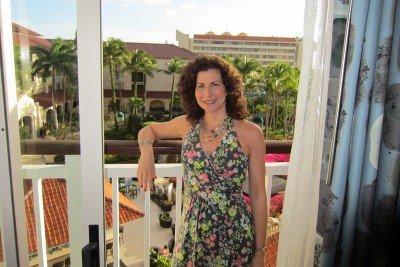Jill’s Story
This Wall Street veteran faced breast cancer with determination. After a diagnosis of stage I invasive ductal carcinoma, Jill underwent a lumpectomy and sentinel node biopsy followed by four weeks of hypofractionated radiation therapy. The treatment is given over a shorter period of time compared with standard radiation therapy and can mean less scarring in the area of treatment. Now, Jill says, “I know I had the best care and made the best decisions.”

Breast cancer survivor Jill enjoying a vacation and embracing a bright future after diagnosis and treatment at MSK.
- Jill was diagnosed with stage I invasive ductal carcinoma, a type of breast cancer.
- Her tumor was discovered during a routine mammogram.
- She underwent a lumpectomy and sentinel lymph node biopsy and four weeks of hypofractionated radiation therapy.
- Jill says her next steps include a vacation and a chance to get on with her life with her husband.
After working on Wall Street for more than 20 years, Jill is used to taking action and focusing on what’s next. When she was diagnosed with breast cancer in the spring of 2016, she knew she needed to keep moving forward. “Time is of the essence,” she says. “And you don’t want the cancer to spread.”
Jill knew the road ahead would be filled with choices and decisions — and her first was to go to Memorial Sloan Kettering for treatment. “Every decision you make matters,” she says. “Cancer chooses you. You can’t control that. But you can control where you will get treated and by whom.”
With a diagnosis of stage I invasive ductal carcinoma, Jill’s next step would be surgery. Her MSK breast surgeon, Hiram Cody, helped her understand her options. Together, they opted for a procedure called a lumpectomy, in which the tumor is removed but the rest of the breast is left intact.
As a surgeon who specializes in breast cancer, Dr. Cody says the options for patients like Jill with early breast cancer just keep getting better. “We’ve come a long way since the 1980s, when a tumor like Jill’s would have required mastectomy, removal of most of her lymph nodes, and chemotherapy,” he says. “She instead had a lumpectomy, a sentinel node biopsy, and a gene profile, which allowed her to avoid chemotherapy, yet her odds of cure are better than ever.”
Though she was able to skip more extensive treatment, Jill still needed radiation to make sure the cancer was completely gone. Looking back, she admits that aspect was what scared her the most. “My biggest fear was being over-radiated and the long-term effects,” she says. “You name it, I was afraid of it when it came to radiation.” But under the care of her MSK radiation oncologist, Beryl McCormick, Jill says she felt like all her questions were answered, and that helped put her mind at ease.
Dr. McCormick recommended hypofractionated radiation therapy, a more highly concentrated treatment than standard radiation therapy that’s also given over a shorter period of time. For patients like Jill, that means four weeks of radiation treatments instead of six. Dr. McCormick says the long-term studies reveal exciting results, beyond just convenience: “The breast cancer control rate and the cosmetic outcome, or lack of scar tissue, is better with the shorter course of radiation. So it’s a win-win situation for the patients.”
Because Jill’s cancer was in her left breast, doctors needed to take special precautions to avoid any unnecessary damage to her heart. To help protect it, Dr. McCormick recommended a technique called deep inspiration breath hold, which meant Jill would have to inhale deeply and hold her breath during every radiation dose.
“That sounded crazy at first,” Jill says. “But after Dr. McCormick explained the science behind it and how it works, it made perfect sense.”
Taking a deep breath and holding it expands the lungs and pushes the heart back so that it’s further away from the breast tissue receiving radiation. Dr. McCormick says it’s a technique often used for women with cancer in their left breast. At MSK, the radiation oncology team makes sure it’s as easy for patients as possible.
MSK’s specially trained staff coached Jill through every breath during each treatment. For all patients who use the technique, radiation technicians use technology that precisely detects movement and automatically stops the radiation beam if it senses any. Patients can breathe a little easier knowing their hearts are protected.
Throughout her treatment, Jill says she never felt like “one of many” going through the process. The receptionists greeted her with a smile and knew her name, and she always felt that if she had a question, she could ask it. “When you have questions about treatments or appointment scheduling, or you need a copy of a report, someone is always there to answer your call or email and is quick to respond,” she says. “They want you to focus on your treatment and well-being. They don’t want you stressing out over not being able to get in contact with them when you need to.”
Jill wants women to know how important it is to follow their doctor’s advice about getting a mammogram. “In my case, the tumor was very small and no lumps were felt, not even by the surgeon,” she says. “I know I had the best care and made the best decisions.”
For now, with her surgery and radiation treatments behind her, Jill’s plan of action is to get away for a little rest and relaxation in Aruba with her husband of 15 years and embrace their bright future together.


